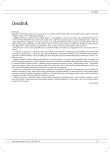Sco2 Protein Deficiency-Based Mitochondrial Encephalomyopathy with the SMA‑like Picture of Neurogenic Muscle Atrophy – Case Reports
Authors:
M. Magner 1; K. Veselá 1; T. Honzík 1; P. Ješina 1; V. Vobruba 1; B. Petrák 2; J. Zeman 1; P. Klement 1
Authors place of work:
Klinika dětského a dorostového lékařství UK 1. LF a VFN v Praze
1; Klinika dětské neurologie UK 2. LF a FN v Motole, Praha
2
Published in the journal:
Cesk Slov Neurol N 2010; 73/106(1): 73-75
Category:
Kazuistika
Summary
Various mitochondrial diseases with clinical, electromyographical and histological signs imitating spinal muscular atrophy (“SMA-like diseases”) with no detected mutation in SMN1 gene have been described in recent years. Respiratory chain disorder was considered due to broad impairment of the central and peripheral nervous systems (encephalopathy, neuropathy) and other tissue and organ involvement (cardiomyopathy, myopathy, hepatopathy). The number of previously-reported mitochondrial syndromes with “SMA-like” sign development is limited. Revealing the phenotype in a detailed clinical context may lead to targeted molecular-genetic analysis and specific diagnostics without calling upon other investigations. A typical representative of this syndrome group is mitochondrial encephalopathy with cardiomyopathy and lactic acidosis arising out of a mutation in gene coding protein Sco2 protein, which is involved in the assembly of mitochondrial cytochrome c oxidase. Two case histories are presented, of patients in whom SMA-like phenotype development led to SCO2 gene investigation and correct diagnosis.
Key words:
mitochondrial encephalopathy – neurogenic muscle atrophy – spinal muscular atrophy – SMA – cytochrome c oxidase – SCO2 gene
Zdroje
1. DiMauro S, Schon EA. Mitochondrial respiratory‑chain diseases. N Engl J Med 2003; 348(26): 2656–2568.
2. Barrientos A, Barros MH, Valnot I, Rötig A, Rustin P, Tzagoloff A. Cytochrome oxidase in health and disease. Gene 2002; 286(1): 53–63.
3. Stiburek L, Hansikova H, Tesarova M, Cerna L, Zeman J. Biogenesis of eukaryotic cytochrome c oxidase. Physiol Res 2006; 55 (Suppl 2): 27–41.
4. Jaksch M, Horvath R, Horn N, Auer DP, Macmillan C, Peters J et al. Homozygosity (E140K) in SCO2 causes delayed infantile onset of cardiomyopathy and neuropathy. Neurology 2001; 57(8): 1440–1446.
5. Vesela K, Hansikova H, Tesarova M, Martasek P, Elleder M, Houstek J et al. Clinical, biochemical and molecular analyses of six patients with isolated cytochrome c oxidase deficiency due to mutations in the SCO2 gene. Acta Paediatr 2004; 93(10): 1312–1317.
6. Tarnopolsky MA, Bourgeois JM, Fu MH, Kataeva G,Shah J, Simon DK et al. Novel SCO2 mutation (G1521A) presenting as a spinal muscular atrophy type I phenotype. Am J Med Genet A 2004; 125(3): 310–314.
7. Galbiati S, Bordoni A, Papadimitriou D, Toscano A,Rodolico C, Katsarou E et al. New mutations in TK2 gene associated with mitochondrial DNA depletion. Pediatric Neurol 2006; 34(3): 177–185.
8. Binder J, Hofmann S, Kreisel S, Wöhrle JC, Bäzner H, Krauss JK et al. Clinical and molecular findings in a patient with a novel mutation in the deafness-dystonia peptide (DDP1) gene. Brain 2003; 126(8):1814–1820.
9. Salviati L, Sacconi S, Rasalan MM, Kronn DF, Braun A,Canoll P at al. Cytochrome c oxidase deficiency due to a novel SCO2 mutation mimics Werdnig-Hoffmann disease. Arch Neurol 2003; 60(5): 749.
Štítky
Dětská neurologie Neurochirurgie NeurologieČlánek vyšel v časopise
Česká a slovenská neurologie a neurochirurgie

2010 Číslo 1
Nejčtenější v tomto čísle
- Mitochondriální encefalomyopatie na podkladě deficitu proteinu Sco2 s obrazem SMA‑like neurogenní svalové atrofie – kazuistiky
- Vyšetření čichu u neurologických onemocnění pomocí Testu parfémovaných fixů
- Kongenitální myastenické syndromy – kazuistiky
- Evokované odpovědi a elektromyografie v intraoperační monitoraci v neurochirurgii
